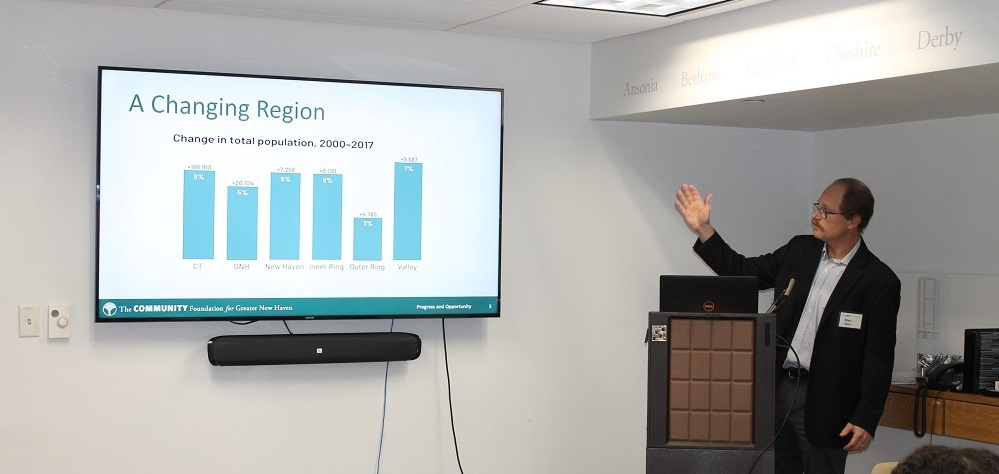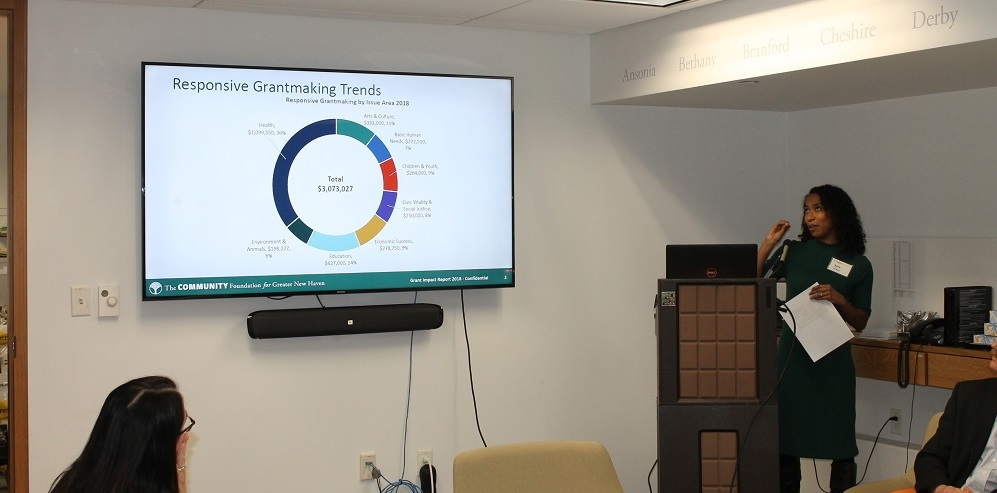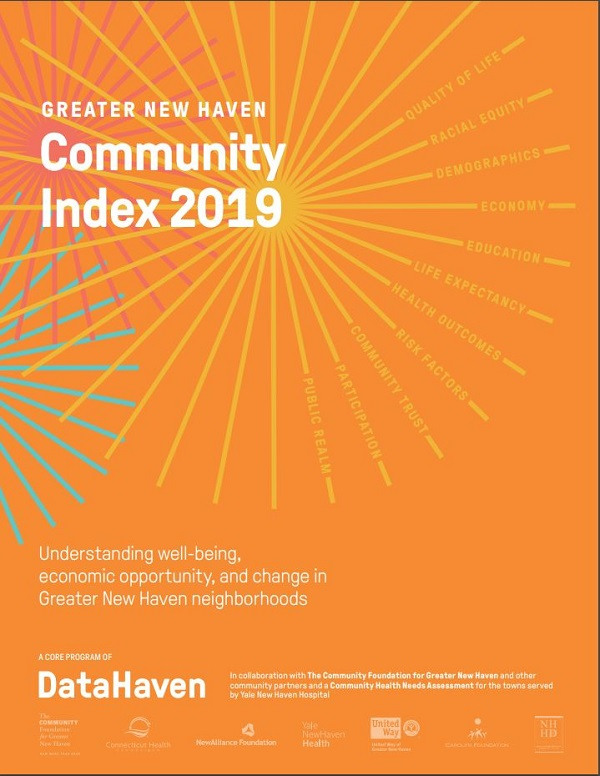Donor Briefing Recap: Community Well-being: Reflections, Responses and Road Maps
Community Foundation staff presented indicators from the recently published Greater New Haven Community Index 2019 at our latest donor briefing, along with the results and impact of recent Community Foundation responsive grants that illustrate the work being done to expand opportunity in the region.
Greater New Haven ranks 17th in well-being among the nation's 107 largest metropolitan regions, according to the recently published Greater New Haven Community Index 2019. And the data also shows where many people in our community face barriers to reaching a secure and healthy life.
At our most recent briefing, Community Foundation staff presented indicators from the recently published Greater New Haven Community Index 2019 along with the results and impact of recent Community Foundation responsive grants that illustrate the work being done to expand opportunity in the region.
Presenters:
Matthew Higbee, Research & Communications Officer, The Community Foundation.
Kara Straun, Knowledge & Evaluation Manager, The Community Foundation.
Moderator:
Christina Ciociola, Senior Vice President for Grantmaking & Strategy, The Community Foundation.
 |
What We Heard: Community Index
New Haven and the Surrounding Towns Are Growing and Changing
- After decades of population decline, the city of New Haven has been growing since 2000.
- Overall, the region's growth lags behind the national rate.
- The region is increasingly diverse. Since 1990, the non-white share of the population in Greater New Haven increased from 21 percent to 38 percent. In the inner-ring (West Haven, East Haven, North Haven and Hamden) the non-white share of the population rose from 13 percent to 41 percent. The share of the non-white population in the outer-ring towns is 14 percent.
The Case for Economic Inclusion
- Despite economic and job growth since the Great Recession, wide disparities in the region continue. Median incomes by town range from $39,000 in New Haven to $110,000 in Orange.
- Long-term trends show a shrinking middle class and rising low-income rates, especially among children. In New Haven, 18,000 children under 18, nearly 2 out of 3, live in low-income households.
- Since 1980, the share of the population that is middle class shrank from 60 percent in 1980 to 47 percent in 2017.
Education Outcomes Are Improving
- Graduation rates up in New Haven. Greater New Haven's four-year high school graduation rates have risen from 80 percent in 2011 to 87 percent in 2017.
- In New Haven, graduation rates among Black and Latino students have increased from 61 percent in 2011 to 78 percent in 2017, the highest among Connecticut's four largest cities.
What We Heard: Grant Impact
 |
Systems and Capacity Strengthened
- Competitive Grants awarded through The Foundation's responsive process strengthened the capacity of individual nonprofit organizations and the sectors as a whole.
Grants Benefited Low-income Residents
- A majority (69%) of grantmaking is directed towards projects and organizations that are working directly with people with low-incomes and living below the federal poverty threshold.
Gains Among Immigration and Juvenile Justice Organizations
Strategic grantmaking to immigration integration and juvenile justice strengthened systems, informed best practices and directly benefited individuals.
Immigration grant results:
- Workers securing past unpaid wages.
- Assistance with bond payments.
- Representation in immigration matters.
- More strongly informed individuals and community.
Juvenile justice grant results
- Decreases in juvenile repeat offenses.
- Decreases in New Haven youth in detention.
- Reduction in school-based arrests.
- Positive changes in policy.
A Win for Homeless Youth
Youth Continuum, during a recent grant term, has grown to become a statewide leader in ending and preventing youth homelessness. It opened Winchester Manor, the state's first and only permanent supportive housing program for chronically homeless and disabled youth.
Stay Informed and Involved
 |
Download the Greater New Haven Community Index 2019: Understanding Well-Being, Economic Opportunity, and Change in Greater New Haven Neighborhoods, a comprehensive, 120-page report with over 85 data graphics that describe the communities and neighborhoods that make up the Greater New Haven region, and uncover the opportunities and issues facing our area.
The DataHaven report is based on federal and statewide data sources, including the 2015 and 2018 DataHaven Community Wellbeing Survey, which conducted live interviews with over 32,000 randomly-selected adults throughout Connecticut last year and weighted the survey responses to be representative of adults living within individual municipalities throughout the state. Survey responses provide further context to population change, health, early childhood, youth and education, economic opportunity, and civic engagement in the region. The survey provides information not otherwise available at a local level, such as respondents' views on effectiveness of local government, financial security, access to resources and basic needs, transportation, and other social and economic issues.
About The Foundation's Donor Briefing Series
As part of coming together around issues that impact our community, The Community Foundation hosts a series of donor briefings featuring local nonprofit and community leaders.Our ongoing Donor Briefing series invites guest experts to discuss urgent issues affecting us locally and nationally and to inform us about what can be done. Contact us to learn more.
